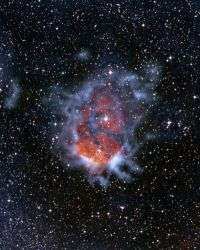APEX reveals glowing stellar nurseries

The region, called RCW120, is about 4200 light years from Earth, towards the constellation of Scorpius. A hot, massive star in its centre is emitting huge amounts of ultraviolet radiation, which ionises the surrounding gas, stripping the electrons from hydrogen atoms and producing the characteristic red glow of so-called H-alpha emission.
As this ionised region expands into space, the associated shock wave sweeps up a layer of the surrounding cold interstellar gas and cosmic dust. This layer becomes unstable and collapses under its own gravity into dense clumps, forming cold, dense clouds of hydrogen where new stars are born. However, as the clouds are still very cold, with temperatures of around -250˚ Celsius, their faint heat glow can only be seen at submillimetre wavelengths. Submillimetre light is therefore vital in studying the earliest stages of the birth and life of stars.
The submillimetre-wavelength data were taken with the LABOCA camera on the 12-m Atacama Pathfinder Experiment (APEX) telescope, located on the 5000 m high plateau of Chajnantor in the Chilean Atacama desert. Thanks to LABOCA's high sensitivity, astronomers were able to detect clumps of cold gas four times fainter than previously possible. Since the brightness of the clumps is a measure of their mass, this also means that astronomers can now study the formation of less massive stars than they could before.
The plateau of Chajnantor is also where ESO, together with international partners, is building a next generation submillimetre telescope, ALMA, the Atacama Large Millimeter/submillimeter Array. ALMA will use over sixty 12-m antennas, linked together over distances of more than 16 km, to form a single, giant telescope.
Source: ESO




















